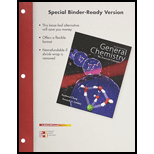
Concept explainers
Interpretation:
Vapor pressure of pure A and B solutions at
Concept introduction:
Raoult’s law states that in an ideal mixture of liquid solution, partial pressure of every component is equal to its mole fraction multiplied into vapour pressure of its pure components.
Where,
Answer to Problem 13.108SP
Vapor pressure of pure A solution =
Vapor pressure of pure B solution =
Record the given data
Vapor pressure of the solution =
Amount of solution A =
Amount of solution B =
Increased vapor pressure of the solution =
Explanation of Solution
Given data are recorded as shown.
To calculate mole fraction of total solution
Substituting in
By plugging in the values of mole fraction of solution A and B, mole fraction of total solution has calculated.
To calculate mole fraction of total solution after additional moles of B

Substituting in
By plugging in the values of mole fraction of solution A and mole fraction of solution after addition of solution B, after additional moles of B has calculated.
To calculate vapor pressure of pure solution of A and B
Substituting equation (1) into (2) we get,
Substituting the value of
By substituting the equation (1) into equation (2), the vapor pressure of pure solution B has calculated and by subtracting this value into
Vapor pressure of pure solution A was calculated as
Vapor pressure of pure solution B was calculated as
Want to see more full solutions like this?
Chapter 13 Solutions
Loose Leaf Version for Chemistry
 ChemistryChemistryISBN:9781305957404Author:Steven S. Zumdahl, Susan A. Zumdahl, Donald J. DeCostePublisher:Cengage Learning
ChemistryChemistryISBN:9781305957404Author:Steven S. Zumdahl, Susan A. Zumdahl, Donald J. DeCostePublisher:Cengage Learning ChemistryChemistryISBN:9781259911156Author:Raymond Chang Dr., Jason Overby ProfessorPublisher:McGraw-Hill Education
ChemistryChemistryISBN:9781259911156Author:Raymond Chang Dr., Jason Overby ProfessorPublisher:McGraw-Hill Education Principles of Instrumental AnalysisChemistryISBN:9781305577213Author:Douglas A. Skoog, F. James Holler, Stanley R. CrouchPublisher:Cengage Learning
Principles of Instrumental AnalysisChemistryISBN:9781305577213Author:Douglas A. Skoog, F. James Holler, Stanley R. CrouchPublisher:Cengage Learning Organic ChemistryChemistryISBN:9780078021558Author:Janice Gorzynski Smith Dr.Publisher:McGraw-Hill Education
Organic ChemistryChemistryISBN:9780078021558Author:Janice Gorzynski Smith Dr.Publisher:McGraw-Hill Education Chemistry: Principles and ReactionsChemistryISBN:9781305079373Author:William L. Masterton, Cecile N. HurleyPublisher:Cengage Learning
Chemistry: Principles and ReactionsChemistryISBN:9781305079373Author:William L. Masterton, Cecile N. HurleyPublisher:Cengage Learning Elementary Principles of Chemical Processes, Bind...ChemistryISBN:9781118431221Author:Richard M. Felder, Ronald W. Rousseau, Lisa G. BullardPublisher:WILEY
Elementary Principles of Chemical Processes, Bind...ChemistryISBN:9781118431221Author:Richard M. Felder, Ronald W. Rousseau, Lisa G. BullardPublisher:WILEY





